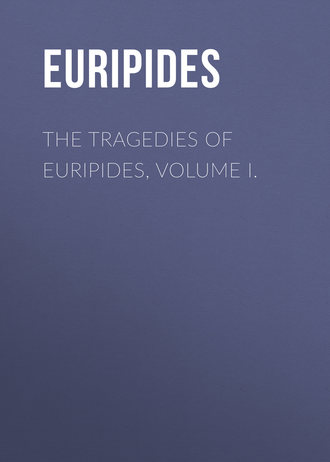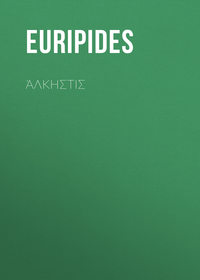 полная версия
полная версияThe Tragedies of Euripides, Volume I.
654
I have recalled the old reading, ‛οσια.
655
On these sort of prodigies, see Musgrave, and Dansq. on Quintus Calaber, xii. 497 sqq.
656
"in eo, ut" is the force of εν εργωι.
657
Perhaps a sly allusion to their escape.
658
See ed. Camb.
659
But we must read τοις τε with the Cambridge editor = "who know more than men."
660
I can not too early impress upon the reader the necessity of a careful attention to the criticisms of the Cambridge editor throughout this difficult chorus, especially to his masterly sketch of the whole, p. 146, 147.
661
φερεν ινιν is Burges' elegant emendation, the credit of which has been unduly claimed by Seidler.
662
i. e. the place afterward called Inopus. See Herm., whose construction I have followed.
663
On the ομφαλος see my note on Æsch. Eum. p. 180, ed. Bohn. On the Delphic priesthood, compare ibid. p. 179.
664
See, however, the Cambridge editor.
665
Read ες θρονον with Barnes and Dind., or rather επι Ζηνος θρονον with Herm.
666
But see Dindorf.
667
See Dindorf's note, but still better the Cambridge editor.
668
I follow Seidler.
669
So ed. Camb.
670
i. e. what evil inspiration of the Gods impelled her to this act? Thoas, who is represented as superstitious to the most barbarian extent, naturally regards the infidelity of Iphigenia as proceeding from the intervention of heaven.
671
Cf. Monk. on Hippol. 828.
672
Cf. vs. 1197. ερημιας δει.
673
Dindorf and the Cambridge editor follow Hermann, who would place this line after vs. 1394.
674
So Musgrave.
675
Seidler has deserved well of this passage, both by his correction τοιν ξενοιν for την ξενην, and by his learned and clear explanation of the nautical terms.
676
Dindorf has adopted Markland's emendation, but I prefer ‛ωστ' εξαναπνειν with the Cambridge editor.
677
i. e. capsize.
678
But see ed. Camb.
679
I have introduced the line above mentioned, and have likewise adopted Hermann's introduction of παλιμπρυμνηδον from Hesychius, in lieu of παλιν πρυμνησι'.
680
See ed. Camb.
681
"The obvious intent of these measures was to fasten the vessel to some point of the rocks, and thus prevent her being wrecked." ED. CAMB.
682
"Our passage is thus to be understood, ‛η ‛αλισκεται προδουσα το μνημονευειν θεαι φονον." ED. CAMB.
683
So Hermann rightly explains the sense. I agree with the Cambridge editor, that if Euripides had intended to use ‛οσιας substantively, he would hardly have joined it with θεας, thereby causing an ambiguity.
684
There is another construction, taking κλιμ. θεας together. On the whole introduction of Minerva, see the clever note of the Cambridge editor, p. 158, 159.
685
There is evidently a lacuna, as the transition to Orestes is worse than abrupt. The mythological allusions in the following lines are well explained in the notes of Barnes and Seidler.
686
On these last verses see the end of the Orestes, with Dindorf's note.
687
Vs. 246, ενθανειν γε. "Pravam esse scripturam dici Brunckius et Corayus viderunt; quorum ille legere voluit ‛ωστ' εντακηναι, hic vero ‛ωστ' εμβαλειν. Sed neuter rem acu tetigit. Euripides scripsit: ‛ωστ' εν γε φυναι, uti patet ex Hom. Il. Ζ. 253, εν τ' αρα ‛οι φυ χειρι, Od. Π. 21, παντα κυσεν περιφυς, Theocrit. Id. xiii. 47, ται δ' εν χερι πασαι εφυσαν, et, quod rem conficit, ex Euripidis ipsius Ion. 891, λευκοις δ' εμφυσας καρποις χειρων." G. BURGES, apud Revue de Philologie, vol. i. No. 5. p. 457.
688
The use of αλλος ‛ετερος is learnedly illustrated by Dindorf.
689
Elmsley, on Heracl. 852, more simply regards the datives σοι σηι τ' αδελφη as dependent upon επισεισω, understanding ‛ωστε δουναι δικην. This is better than to suppose (with Porson) that δουναι δικην can mean to inflict punishment.
690
Dindorf (in his notes) agrees with Porson in omitting the following verse.
691
Dindorf rightly approves the explanation of Musgrave, who takes στεφανοισι, like the Latin corona, to mean the assemblies. He translates: "nec in pulchros choros ducentibus circulis juventutis."
692
The full sense, as laid down by Schœfer and Dindorf, is, "for ever when an old man travels, whether in a carriage, or on foot, he requires help from others." πασα απηνη πους τε is rather boldly used, but is not without example.
693
These three lines are condemned by Valck. and Dind.
694
Matthiæ attempts to explain these words as follows: "εμπυροι ακμαι may be put for τα εμπυρα, in which the seers observed (ενωμων) two things, viz. the divisions (‛ρηξεις) of the flame, which, if it slid round the altars, was of ill omen (hence ‛υγραι, i.e. gliding gently around the altars with many curves, for which is put ‛υγροτης εναντια); and 2dly, the upright shooting of the flame, ακραν λαμπαδα."





